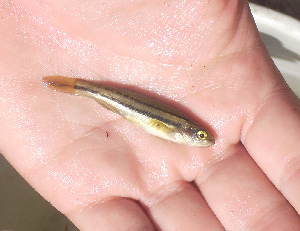Northern Redbelly Dace
Chrosomus eos
 Distribution: The northern redbelly dace has a northern distribution in North America, inhabiting most of Canada, with isolated populations in the Missouri and upper Mississippi River watersheds, northern New York, Pennsylvania, Massachusetts, Vermont, New Hampshire, and Maine. In New Hampshire, northern redbelly dace populations occur north of the White Mountains, in the Androscoggin and upper Connecticut River watersheds, with isolated populations as far south as the Sugar and Cold River watersheds.
Distribution: The northern redbelly dace has a northern distribution in North America, inhabiting most of Canada, with isolated populations in the Missouri and upper Mississippi River watersheds, northern New York, Pennsylvania, Massachusetts, Vermont, New Hampshire, and Maine. In New Hampshire, northern redbelly dace populations occur north of the White Mountains, in the Androscoggin and upper Connecticut River watersheds, with isolated populations as far south as the Sugar and Cold River watersheds.
Description: The northern redbelly dace is a small to medium sized minnow species with two parallel, black lateral bands, a terminal mouth, and very small scales. It looks very similar to the finescale dace, which has just one black lateral band. Where they overlap, the two species may hybridize and the offspring retain characteristics from both species. Finescale dace and northern redbelly dace may also be distinguished by the length of their intestines. The intestine of the finescale dace is shorter than the length of its body, with a single “S” turn. The intestine of the redbelly dace is long and coiled. Northern redbelly dace sometimes co-occur with blacknose dace, but may be distinguished by the position of the mouth, which is below the tip of the snout in the blacknose dace and right at the tip of the snout in the redbelly dace. Male northern redbelly dace become brightly colored in red or yellow and grow tubercles during the breeding season.
Species commonly confused with: Finescale dace, blacknose dace
Habitat: Northern redbelly dace prefer cool headwater streams and small ponds with sluggish flow and ample cover from over hanging shrubs or aquatic vegetation. They tend to thrive in areas with a history of beaver activity. Individuals may be found in rivers or steams with higher gradients and flow, but they are assumed to have either washed out of or dispersed from areas of more suitable habitat.
Life History: Northern redbelly dace are an omnivorous minnow species, which feeds on far more plant material than its close relative, the finescale dace. Detritus, filamentous algae, and small invertebrates make up the bulk of its diet. The primary predators of northern redbelly dace are birds, such as herons or king fishers, and predacious insect, including the giant water bug. They are particularly well adapted to living in streams with beaver dams in various states of activity. This habitat may offer protection from large predacious fish species, with which northern redbelly dace rarely coexist.
Spawning has been observed in dense mats of filamentous algae, where the female is accompanied by a male or group of males as she deposits 5 to 30 un-adhesive eggs per spawning event. Eggs hatch in 8 to 10 days. Northern redbelly dace may spawn more than once per year, with the spawning season extending into late summer. Adapted to thick ice cover and low oxygen levels, finescale dace are well suited to living in northern climates, although they are slightly more tolerant of warm water conditions than finescale dace. Individuals may live for up to 4 years and reach 4 inches in length.
Where finescale dace overlap with northern redbelly dace, hybridization may occur. The offspring tend to be all female and diploid, meaning that they contain a full set of chromosomes from each parent. The hybrids are able to reproduce clonally and they share characteristics from both species, including a more omnivorous diet. Northern redbelly dace usually spawn about two weeks later than redbelly dace in warmer water temperatures (19°C/67°F for redbelly dace and 16°C/60°F for finescale dace). Hybridization occurs in areas where rapid temperature increases in spring may cause more overlap between the spawning seasons of the two species.

Origin: Native
Conservation/Management: Northern redbelly dace are vulnerable to habitat alterations that reduce summer base flows and riparian cover. Populations upstream of dams are also vulnerable to artificial water level fluctuations, especially during spawning. The extent of their distribution in New Hampshire is not well understood. Although aquatic habitats in northern New Hampshire are under less pressure from development than those of southern New Hampshire, there may be certain regions that are important for the persistence of the species, which has somewhat limited dispersal abilities.
The biggest threat to northern redbelly dace populations may be the introduction of large predatory fish species, including bass, pike, and sunfish. The brightly colored breeding males, in particular, are not well adapted to avoiding larger fish predators. Preventing illegal fish species introductions may be prove to be an important strategy for protecting northern redbelly dace populations. As a species adapted to cold climates, the range of the northern redbelly dace may be reduced in the future due to the effects of climate change.



